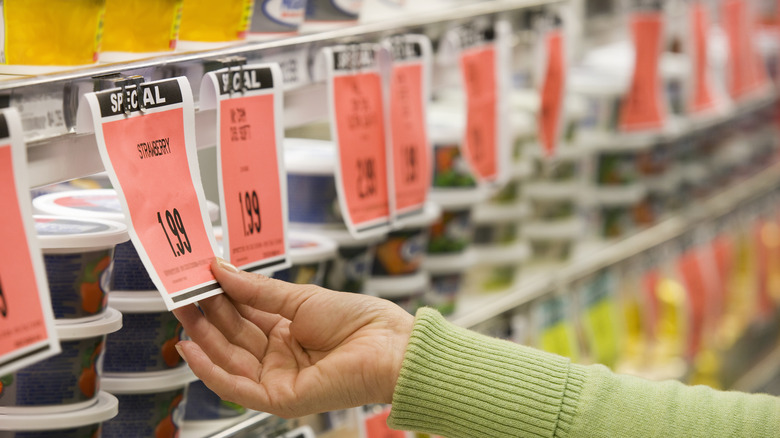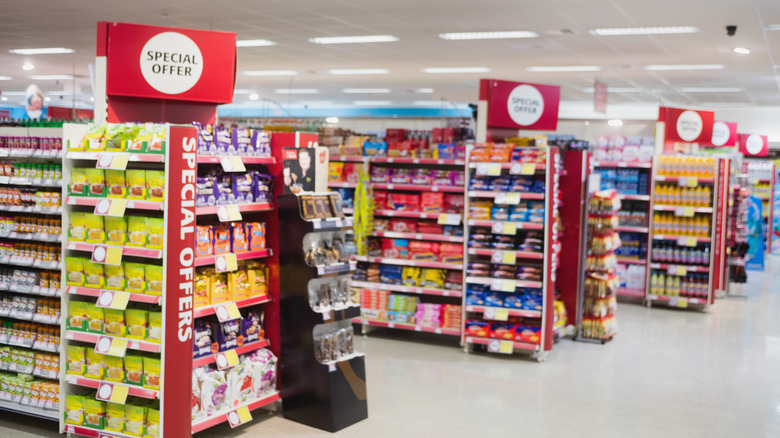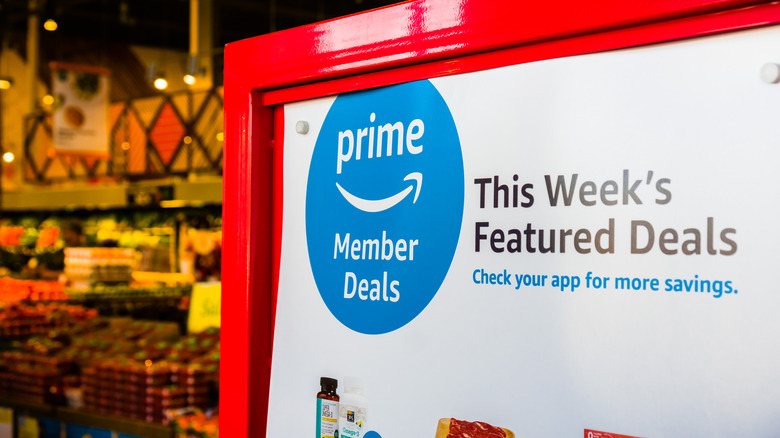The Trap Everyone Falls For With Grocery Store Sales
Grocery store planners are tricksy. Their sales tactics are so good that you'll put the extra items into your cart with your own two hands before you even realize what you're doing. It's like you've fallen victim to some sort of hypnotic mist that's being piped into the grocery aisles via the store's public address system. There is no real hypnosis at play of course, but that doesn't mean there aren't plenty of tricks afoot. Fortunately, Understanding Grocery Store Marketing Psychology 101 helps you avoid being hoodwinked.
Most sale signs in grocery stores are red. Ever wondered why? People have learned to associate the color red with danger, but what's really the danger here? In most cases, it's sales psychology or even FOMO. In other words, the red sign tricks consumers into believing that the item is on sale at a special price and usually only for a limited time at that. If a product will only be at that price for a day, then the fear of missing out prompts shoppers to buy it immediately, even if they don't need it.
But here's the rub: Many Big Box retailers offer those same items at the sale price most, if not all, of the time. The big, screaming red tag only makes consumers think that they're getting a better price. Often, they're not. And sometimes, to trick people even further, retail outlets jack up the price in the weeks prior to the promo to make the sale price seem like a total bargain by comparison.
Proximity also plays a role
It isn't just the items that are "on sale" that move in such a scenario. The products displayed around them tend to fly off the shelves faster, too. For example, the store marks a popular pasta sauce with a special price and then flags the sale with a red tag. The red tag and the sale item grab shoppers' attention but so, too, do the items around it, even if those products aren't being sold for a special price (bogus special price or not). When people are shopping to save money, price isn't absolute. Instead, it's relative to the other items around it. Store planners use this knowledge to get you to buy more. By setting up their displays this way, they "comparison shop" for the customer, though it doesn't typically favor the buyer.
Thanks to the proximity principle, consumers buy more of all the items, not just the product on sale. The principle of proximity also comes into play with the sale price versus the unit price. The latter refers to the cost-per-ounce for the item. Imagine there are two different brands of salad dressing side by side on the shelf. The price for one of them is $2.50, while the other is $3.50. A look at the unit price on each is 20 cents versus 10 cents, respectively. In other words, the $3 bottle actually costs less per ounce than the $2 bottle, even though the price tag is higher.
Other ways you're tricked
If you've ever been shopping for something and have noticed the signs sport both member and non-member prices, you've seen this principle in action. The members' prices tend to be much lower, sometimes even by half. However, the problem with memberships boils down primarily to shopping frequency. Consider that you're out running errands in a section of town you don't normally visit and while you're there, you remember that you need coffee. You stop at a grocery store that has a membership program. You find this out when you peruse the price for a bag of java. A 24-ounce bag costs members $12 while the non-members' price is $30.
When you go to pay for the coffee, the cashier asks if you want a $120 annual membership to help you offset the price, explaining that given the difference between members and non-members, it will pay for itself in just six or seven visits. However, if you don't shop at the store often enough to make it worth the price, you'll pay less even if you shell out $30 for the java. Truthfully, you're better off buying a monthly coffee subscription because that comes with swag too. You're also wasting gas money every time you have to drive out of your way to shop at that store just because you want to save money on coffee, so it all comes out in the wash.


